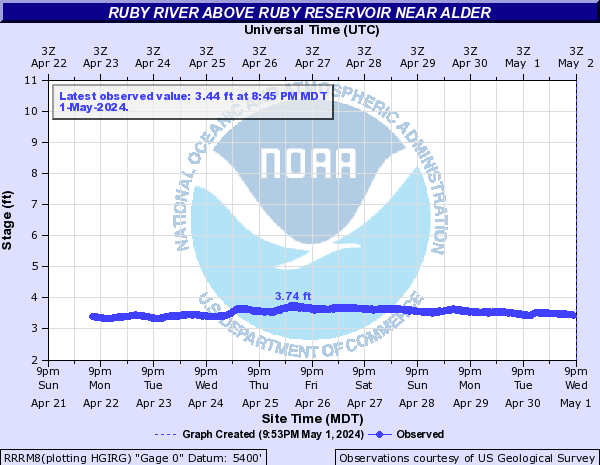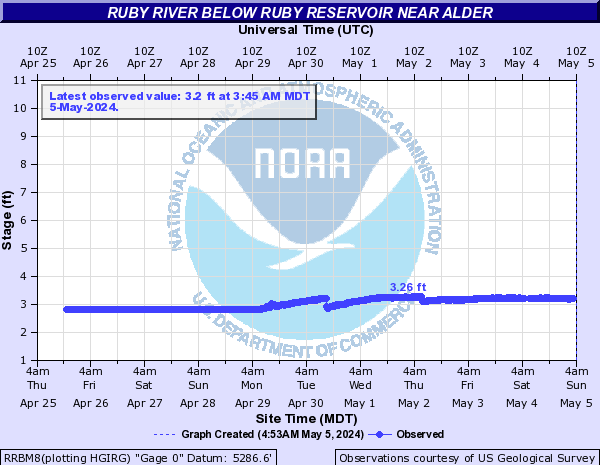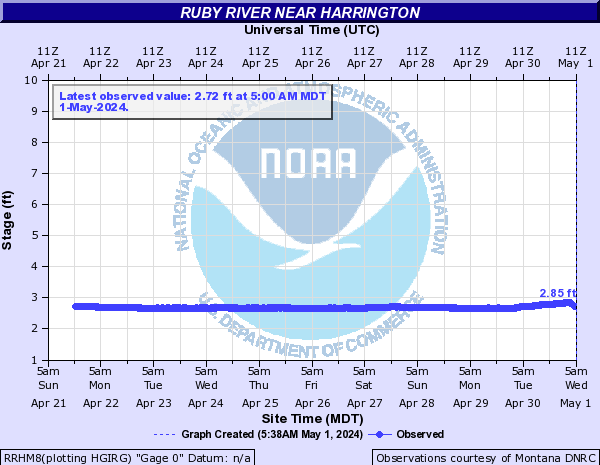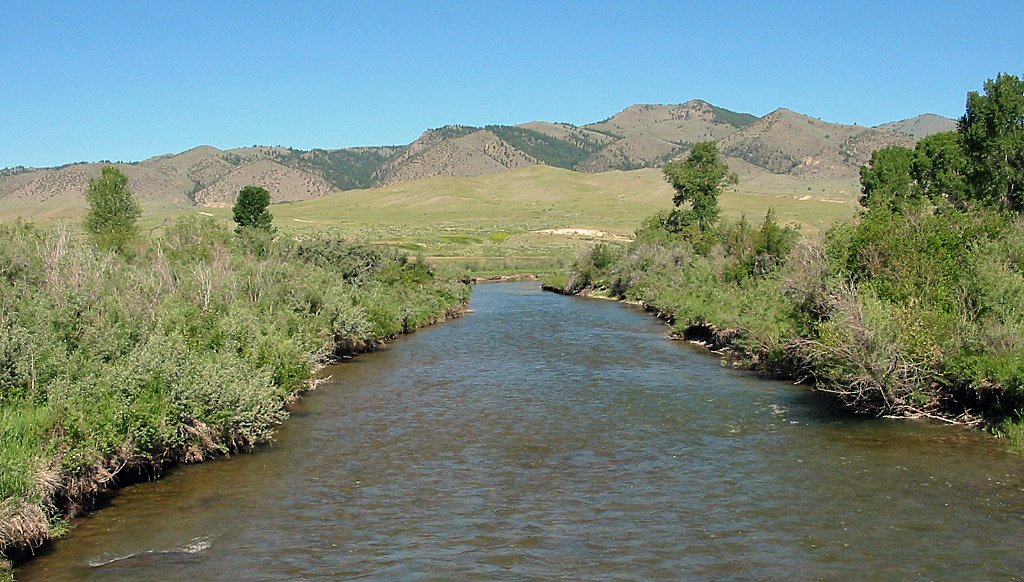The Ruby River begins in the Gravelly Range of southwest Montana. The river flows down these mountains into a broad, arid valley and then into Ruby Reservoir. Below the reservoir, the river flows in a valley that lies between the Ruby Range to the south and the very scenic Tobacco Root mountains to the north. The river ends with the confluence of the Jefferson River at Twin Bridges.
Table of Contents:
- Ruby River – Introduction & Overview
- Fishing the Ruby River
- Floating & Paddling the Ruby River
- Current River Flows
Related Article – Ruby River Photographs
Introduction to the Ruby River
The Ruby River has very difficult access in comparison to other Montana rivers. Except for the very upper stretch of the river, which lies in National Forest land, the river flows primarily through private property. And for whatever reason, many of the landowners along the Ruby River are less than cordial to anglers who are fly fishing, in stark contrast to other regions of the state. Gaining access to the Ruby River by roads is also difficult above Ruby Reservoir, since only a few roads cross the river. Finally, the river itself is located in a remote section of the state.
However, for those willing to tackle the difficulty of accessing it, the Ruby River provides very good fly fishing with lots of solitude for those who are floating or for the wade angler willing to venture away from the few public access sites.
The river itself is quite narrow with lots of twists and turns. The river also has very bushy banks that often make casting difficult. The river also has undercut banks and some deep holes.
Due to the difficulty of access and the fact that the Ruby River is found within striking distance of better-known rivers such as the Big Hole, Beaverhead and the Madison, the Ruby River does not receive extensively high fly fishing pressure. However, the best fly fishing is found well away from the fishing access sites, particularly in the upper portion of the river where access sites are quite scattered and their use is heavy.
Fishing the Ruby River
The Ruby River, despite some past battles with whirling disease and a massive fish kill in the lower stretches in1994, continues to provide excellent fishing.
The upper stretch of the Ruby River, above Ruby Reservoir, has excellent fly fishing for average sized rainbows, cutthroats and grayling. The lower stretch of the river, below Ruby Dam, provides excellent brown trout fishing. The average size of browns runs between 10-14 inches, with some fish stretching 18-20 inches. While the browns may not get as large in the Ruby as in other nearby rivers, the lower fishing pressure on the river makes the fish somewhat easier to catch.
Origin Ruby River to Ruby Reservoir
The upper stretch of the river, above Ruby Reservoir, is excellent habitat for rainbows, cutthroats and a few grayling that have been introduced. The river here is quite narrow and twists extensively. While in the national forest, the banks of the river are a mix of grass, forests and brush. Once the river leaves the national forest and enters the Ruby Valley, the river starts to flow through extensive brushy sections.
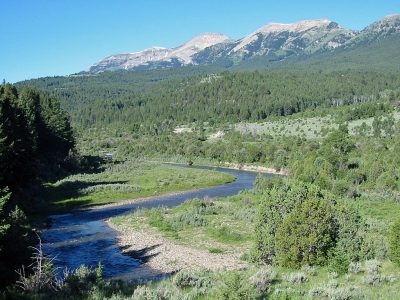
The Upper Ruby River & the Snowcrest Mountain Range
For anglers who are not in search of trophy trout but are rather seeking to fly fish in a pristine and remote setting, consider fishing the upper Ruby River within the national forest lands. The mountains provide a very scenic backdrop, the river itself runs clear, fishing pressure is low to non-existent and access is excellent.
Once the Ruby River leaves the national forest lands, access to the upper river becomes very difficult since it runs entirely through private lands. Access is only possible at a few bridge crossings, none of which are easy due to tall fences erected by landowners, that run right up to the bridge.
For the angler who can scale these fences, be prepared to fish and wade within the river, not along the riverbanks. The narrow width of the Ruby, combined with its extensive brushy banks, make fishing from shore very difficult once the Ruby leaves national forest lands. Additionally, much of the Ruby River lacks a distinct high water mark, requiring anglers to wade directly in the stream to reach prime fly fishing holes away from the few bridge access sites.
Brown trout are also found on this stretch of river just above the inlet to Ruby Reservoir. To reach these fish, a very small boat—such as an inflatable kayak or tiny inflatable raft—is needed, since access to the river above the reservoir inlet is difficult. Put a boat into the reservoir and paddle up the river. Most rainbows in the Upper Ruby run 8-12 inches.
Ruby Dam to Jefferson River
Below Ruby Dam is where the prime brown trout fishing waters are located. Access is also somewhat better than found upstream since several designated fishing access sites and frequent bridge crossings provide decent access to the river. The river, similar to upstream, is very narrow and twists extensively. Very thick brush lines the banks for most of its length, making fly fishing from shore difficult.
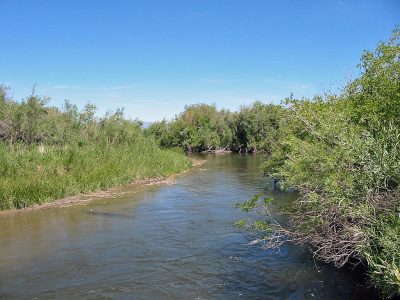
Be prepared for lots of ” brushy banks” when fly fishing the Ruby River in Montana.
Due to extensive irrigation withdrawals, the Ruby River loses much of its flows as it travels downstream from the dam, thus reducing fly fishing quality.
Fishing pressure on this stretch is heavier than found above Ruby Reservoir, but it is not abnormally heavy. For an angler willing to wade directly in the stream for some distance (walking along the banks is generally impossible), an angler can find solitude away from the standard access sites.
Since this is prime brown trout water, standard brown trout tactics work well. Unlike the brown trout in many other waters, the fish are not nearly as finicky about what they eat. However, as the Ruby River more resembles a spring creek in this section than a river, care must be taken when wading to avoid spooking the fish.
This section of the Ruby River flows through prime grasshopper country (very arid, somewhat windy with lots of grass beyond the riverbanks). Thus, it should probably be no surprise that hoppers are the flies of choice during summer. The Ruby River is considered to be one of the prime hopper fishing waters in the state, with hopper fishing possible from late June to the first hard frost of the year.
When hoppers aren’t working, other flies to use f are big attractor patterns such as the wolly bugger and various minnow patterns, stripped erratically along the bottom, especially near the undercut banks. For the rainbows, pale morning duns, elk hair caddis and X wing caddis imitations all work well. Tricos in tiny sizes also have success later in the summer.
Floating & Paddling the Ruby River
The Ruby River is an easy float for all skill levels, although the many fences, its narrow width, shallow depth and irrigation hazards can make for interesting and frustrating portages.
Good floating, when water levels are at least fairly high, begins at the confluence of the East Fork Ruby River and the West Fork Ruby River. This stretch of river is located on National Forest land, so access is easy. A campground called Cow Camp provides the best access.
In order to float this stretch, or any stretch of the Ruby River for that matter, don’t even consider using a large boat or raft. About the only boat that can float the Ruby River successfully and easily is an inflatable kayak or very small inflatable raft. These narrow boats are easy to turn, don’t take up the entire rivers width and only draw a couple of inches of depth. While a standard canoe can work, the frequent shallow depth often requires dragging the canoe across the river bottom.
For most of its length, the Ruby River has a moderate current. Some slow water stretches are found the last couple of miles.
Any floater travelling down the length of the Ruby River will have to traverse Ruby Reservoir. Happily, this reservoir is relatively small, allowing for an easy paddle across. Since any floater should be using a small inflatable raft or kayak, the portage of the dam should be fairly easy if time consuming.
As one floats further downstream from Ruby Dam, expect the river to get narrower and shallower due to irrigation withdrawals. Even in an inflatable kayak, portages are often required around low water stretches, fences, irrigation pipes and dams.
Ruby River : Selected River Miles
Listed below are selected river miles for the Ruby River in Montana. You can get additional information about a specific fishing access site by visiting the Montana FWP Site.
- Origin at Divide Creek: 103
- Cow Camp Campground: 92
- Cottonwood Camp: 86
- Ledford Creek Bridge Access Site: 69
- Sweetwater Creek Bridge Access Site: 56
- Ruby Reservoir Inlet: 51
- Ruby Dam FAS: 45.2
- Vigilante FAS: 43.7
- Coy Brown Bridge FAS: 40.6
- Alder Bridge FAS: 38.4
- Silver Springs Bridge FAS: 19.3
- County Bridge: 14
- County Bridge: 7
- County Bridge: 2
- Confluence with Jefferson River in Twin Bridges: 0
Related Articles on Big Sky Fishing.Com
Current River Flows of the Ruby River
